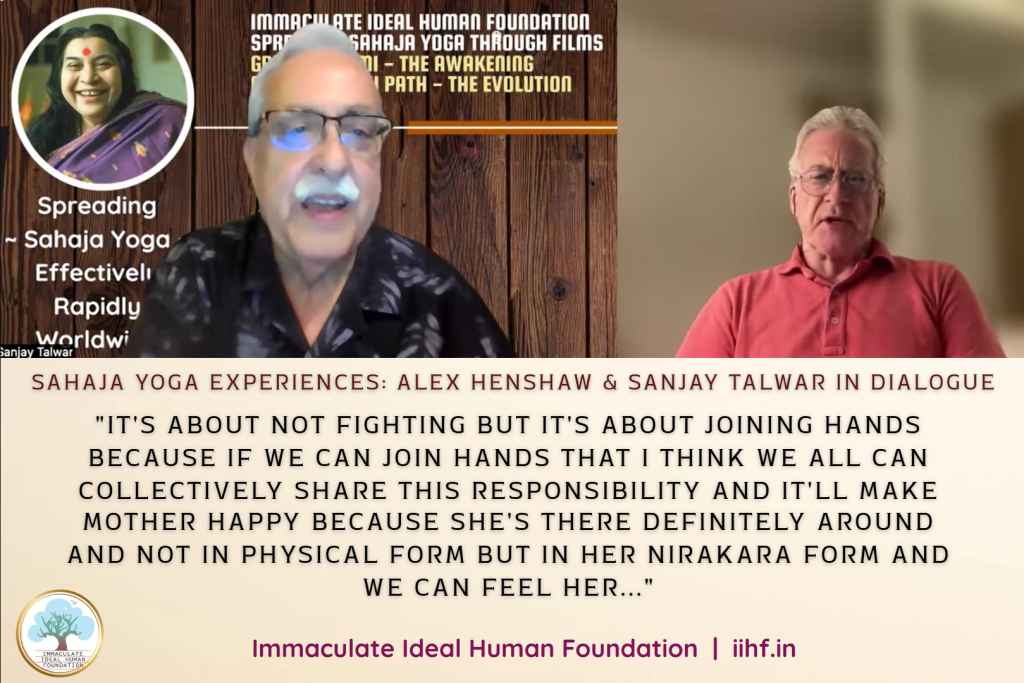Sahaja Yoga Experiences: Alex Henshaw & Sanjay Talwar in Dialogue
-
Introduction of Alex Henshaw: The speaker introduces Alex Henshaw from Hong Kong (and Southeast Asia, Australia), a Sahaja Yogi since the early 1980s, for a special interview about his miraculous journey and transformation in Sahaja Yoga.
-
Alex’s Background and Stress: Alex received his self-realization in April 1983 in Sydney, Australia. He was a stressed industrial design student juggling studies and music.
-
Mother’s Entry into Sahaja Yoga: His mother, a “diehard seeker,” heard Shri Mataji interviewed on the radio. Shri Mataji spoke of the “power of God’s love” and invited listeners to put their hands out and ask for self-realization. Mother felt a tremendous cool breeze before even asking, profoundly impressing her.
-
Family’s Realization and Alex’s Initial Miss: Alex’s mother urged the family to meet Shri Mataji. His parents and younger siblings attended a program and his father, an intellectual and founder of the Jung society, immediately recognized it as a “genuine experience” and a “major breakthrough in consciousness.” Alex, tied up with studies, missed Shri Mataji’s initial visit.
-
Alex’s Self-Realization Experience: A couple of weeks later, Alex went to the ashram and received his self-realization. He had a profound, blissful experience, feeling “on the seventh heaven,” “completely blissed out floating,” and having a “deep sense of knowing everything.” He describes being in this state for a long time before slowly returning to physical consciousness, filled with speechless joy for two weeks.
-
Challenges and Initial Learnings: The bliss was interrupted by a strong headache upon returning to university, indicating blockages. He began diligently clearing his chakras and absorbing Shri Mataji’s teachings from programs and video talks.
-
Early Insights and Dedication: Within two weeks, Alex had a strong insight that Shri Mataji was the “feminine power of God,” Mother Mary. He also felt he had “served her in previous lives.” This strong feeling of service propelled his spiritual ascent.
-
Ashram Life and Degree Completion: He moved into the ashram to dedicate himself to spiritual ascent but realized he was behind on his degree. He wrote a letter to Shri Mataji, expressing gratitude for self-realization and asking for blessings for his studies.
-
Miracle of the Thesis: Shri Mataji’s reassuring message (“don’t worry about anything… I’m with you”) led to a miraculous completion of his 500-page thesis. After surrendering to Shri Mataji, he received a clear plan for the thesis in meditation, completed it quickly, and received a high distinction, topping his year.
-
Early Ashram Discipline: Alex describes the disciplined ashram life (5 AM conch, 5:30 AM meditation, aarti, collective chores, regular clearing, head rubs, supporting programs). This discipline set him up for the future and helped in spiritual ascent by confronting ego in collective living.
-
Ashram Growth and Leadership: James Blackley, the Australian leader at the time, managed Sahaja Yoga like a sales organization with targets for realization and new ashrams, leading to rapid growth (15 ashrams in Sydney at one point) and large tours to India.
-
Challenges of Collective Living: Alex acknowledges the “dramas” and “crazy people” in the ashram, dealing with individuals battling addictions and other afflictions, but it fostered deep bonds and friendships.
-
Learning from Talks: His job copying Shri Mataji’s video talks allowed him to re-listen repeatedly, deeply absorbing her profound message, especially from the early talks of the 70s and 80s.
-
Second Miracle – Design Project and Job: He surrendered his final design project to Shri Mataji, receiving inspiration that led to its completion. He presented it to experts, receiving spontaneous answers during a meditative state. He received the top mark, an Australian Design Award, and was immediately offered a job after graduation, unlike most other graduates. The employer even allowed him to take a year off for travel with a guaranteed job upon return.
-
First India Tour (1983-84): His first trip outside Australia was to the India tour (second phase of the 83-84 tour), arriving in Mumbai. He describes the sensory shock (heat, smell), waiting for buses, and witnessing daily life, feeling it was like a “movie.”
-
Arrival at Bodhi and Meeting Shri Mataji: Despite the physical challenges, he had an “innate feeling” of “coming home” spiritually and great anticipation to see Shri Mataji. At Bodhi, he witnessed Shri Mataji arrive, who saw him, did a namaskar, and spoke to the collective, showing immediate motherly concern for their well-being (food, settling in). This welcome, combined with intense vibrations, was a very special experience.
-
Collective Consciousness and Unity:
- Sahaja Yoga fosters a sense of one big family from diverse backgrounds and cultures, united by the shared experience of self-realization and having Shri Mataji as their Mother.
- Shri Mataji taught that this is “collective consciousness,” dissolving boundaries and making everyone “one with the whole universe,” like cells in a body, all part of Mother herself.
-
Fulfilling Shri Mataji’s Vision (Work in Progress):
- The journey over the past 40-45 years since Shri Mataji’s departure is a “work in progress” in fulfilling her vision for humanity’s transformation.
- Early Sahaja Yogis had direct, correcting, and guiding interaction with Shri Mataji. Now, the collective needs to rise to a “higher level of consciousness.”
-
Challenges of Organization and Ego:
- The “human elements” of organizational structures and attempts to build a “religion” around Sahaja Yoga can lead to rigidity and ego.
- Unlike other incarnations, Sahaja Yoga offers a direct connection to divinity (Kundalini awakening) with no inherent hierarchy.
- Leaders in positions of power can fall into ego traps, and Shri Mataji was known to remove those who did.
-
Maintaining a Grassroots Movement:
- Sahaja Yoga is a “grassroots movement,” not a hierarchical structure. Mistakes are made when leaders act as if they are “there for life.”
- Shri Mataji suggested changing leadership every three to five years to maintain “flow of vibrations” and keep people honest.
- Administrative/legal aspects of the organization are a “very small part” and should not overshadow the spiritual essence.
-
Evolution and Becoming One’s Own Master:
- Sahaja Yoga is a “living process” that evolves; it’s not fixed. Shri Mataji showed this evolution throughout her lifetime.
- The most important goal is to empower individuals to become their “own masters,” their “own guru,” becoming a “vehicle for the divine.”
- This individual transformation will lead to the transformation of society when a “critical mass” of connected people is reached.
-
The Importance of Love, Forgiveness, and Positive Attention:
- Sanjay shares Shri Mataji’s teaching on forgiveness: she taught him to have the “compassion of a mother” and forgive others, as she did for all her children. This became a mantra for him.
- Alex echoes this, emphasizing that Shri Mataji’s “first joy is seeing us loving each other.”
- Focusing on negativity, criticism, and finding faults lowers one’s vibrational frequency. Remaining positive, loving, and compassionate lifts the collective vibration.
- The goal is to be an “instrument and a reflector of that divine energy and love,” like the saints, living up to the expectation of being saints themselves.
-
The Urgency of Spreading Sahaja Yoga:
- There is an “urgency” to share the knowledge and experience of Sahaja Yoga with the greater world and seekers.
- Personal transformation stories are powerful tools for this, especially through modern multimedia (YouTube, TikTok, Instagram).
- Sahaja Yogis have a “job to do” beyond self-enjoyment: to “emancipate,” “help,” and “guide others to Mother,” creating a critical mass for positive change.
-
Understanding the “Divine Play”:
- World events (pandemics, economic collapses, potential wars) are part of Shri Mataji’s “bigger than the Mahabharata” play to bring humanity to the realization that life is not just about the physical world or fixed religions, but about becoming one’s Spirit and realizing the divinity within the heart.
- Shri Mataji postponed Doomsday (predicted for 1970) through her intervention, making it the Sahaja Yogis’ responsibility to continue her work of transforming humanity.
-
Future Direction:
- Maintaining an “inner connection with Shri Mataji” ensures guidance and inspiration.
- Humility and surrender are key: “She does it all,” and ego involvement hinders progress.
- Have faith in Shri Mataji and in oneself as her children, allowing “vibrational awareness” to flow.
- Encourage the younger generation to get involved and utilize multimedia tools to share their transformation stories.
- Emphasize unity, love, and protection among Sahaja Yogis, joining hands to fulfill Mother’s work.

